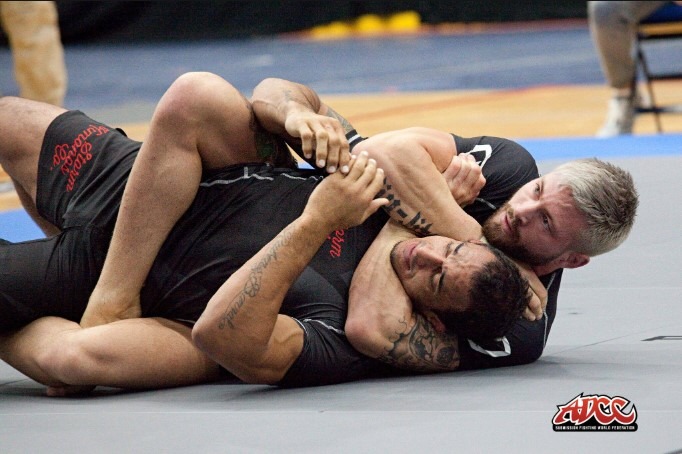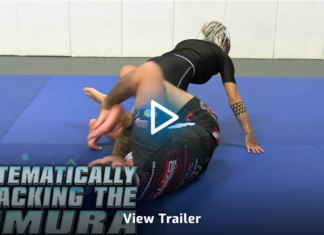
No-Gi BJJ is a far more challenging discipline than it’s the counterpart, Gi Jiu-Jitsu. With the Gi, people have the opportunity to stay in control much more efficiently. Even people that have no idea how to use it, can just cling on for dear life and get a result. Moreover, it is of real help in setting up and finishing submissions. Whether it is your own or your opponent’s Gi, you can use it to choke people out or even do armlocks. No wonder wrestlers and No-Gi people that give the Gi a try are usually lost for a few sessions before they get the hang of it. On the other hand, in No-Gi you need to know how to be dynamic and which moves work. The submission rate in No-Gi is way different than in Gi due to the smaller number of opportunistic submissions available.
So, whenever rolling or fighting in No-Gi Jiu-Jitsu, the submissions of choice are chokes. Yes, it may seem contrary to the No-Gi leg locking trend of today but bear with me. One major reason why chokes are on the top of the pile in terms of No-Gi Jiu-Jitsu submissions is positioning. Most chokes, or at least those that work, are done from very dominant positions in Brazilian Jiu-Jitsu. The mount, back or front headlock are amazing controlling positions that offer a huge variety of chokes. Furthermore, another reason why chokes are optimal for No-Gi Jiu-Jitsu is safety. Executing a Rear Naked Choke poses absolutely no threat to you while giving you total control and high efficiency.
The Ultimate No-Gi Chokes
When talking about the potentially most devastating submissions in grappling martial arts, people tend to overlook chokes. Yes, a kneebar or an Armbar might seem to be more horrible than just putting someone to sleep, but the truth is very different. When you cut off the flow of blood or air the body goes straight into panic mode. The reason is that it is trying to protect its most vital asset – the brain. Now imagine that you’re just sticking with a choke for a couple of minutes. That’s a couple of minutes too long for the brain to be deprived of oxygen. The result is inevitable brain damage and certain death if a choke is kept long enough. As peaceful as it may seem, a choke is the most lethal weapon in a grappler’s arsenal.
When it comes to No-Gi BJJ chokes are the best way to finish a particularly strong and tenacious opponent. Some people have freakish flexibility and simply refuse to tap to joint locks on the arms or legs. Some are just explosive and very well versed at using the slippery environment in No-Gi BJJ to slip out of holds. In that sense, no neck flexibility is going to get you out of a choke. Neck strength is also not a factor, given that positioning and choke mechanics are in order. In terms of slipping out, it is a possibility with chokes, but to a far lesser extent than with joint locks. Chokes are also moves that don’t just work in a flash but can be applied over a longer period. That way you get both complete control and submission that slowly clamps around your opponent.
Let’s look at the highest percentage No-Gi BJJ chokes to increase your submission rate without the Gi.
Rear Naked Choke
The staple of Brazilian Jiu-Jitsu and the proverbial king of chokes, the Rear Naked Choke is by far the highest percentage choke in the sport. While also applicable in the Gi, it is tailor-made for No-Gi Brazilian Jiu-Jitsu or MMA conditions. It is only fitting that the king of submissions is done by the king of positions – back control.
The Rear Naked Choke is the choke you see in movies that instantly puts people to sleep. While it is effective things do not work like that in real life, especially against a resisting opponent. You need to be in a perfect back position in order to get a Rear Naked Choke. The main control points are having two hooks that control the opponent’s hips, as well as a tight Seat Belt grip. The next thing to consider is your head. It has to be over the opponent’s shoulder and next to their ear as much as possible.
There are numerous ways in which you can thread the arms through to the figure 4 position which are beyond the scope of this article. Also, expect to grip fight for a while before you’re able to get into a choking position. As far as mechanics go, your forearm should be on one side of your opponent’s neck, and your upper arm on the other. The rule of thumb is having your elbow right below their chin. From there, it’s all about staying tight, squeezing, and pulling back. A real Brazilian Jiu-Jitsu classic.

Guillotine
The Guillotine choke is one of those chokes that people either love or hate. Very few people usually change their mind about it once they decide they like or hate it. I was one of the lucky ones in giving it a second chance. Now, it’s one of my top weapons.
The front headlock position is one that Brazilian Jiu-Jitsu borrowed from wrestling. In No-Gi BJJ, when Gi grips are not a factor, it is a great position to be in. It is attainable from the first contact and can take a fight from standing all the way to a submission very easily. The guillotine is almost a given submission from this position.
There are plenty of Guillotine choke variations available out there, but only a couple are used on a regular basis. The arm-in guillotine and the Marcelotine or high elbow guillotine are the most effective variations of the choke out there. For a guillotine, you need your forearm (near your wrist) under the opponent’s neck. The other arm grips either directly on the other side (Marcelotine) or under the opposite side arm (arm-in guillotine). From there, it’s BJJ basics for the finish – elbows in, crunch to the side and twist. The guillotine is one of those slow chokes, where you need to count at least to ten before considering letting go or re-adjusting. it also has the added benefit of being either blood or an air choke.
D’arce / Anaconda Chokes
The D’arce and Anaconda choke are not only similar in terms of execution but are also very compatible with each other. Whenever you have an Anaconda choke on one side, the D’arce is there on the opposite. And vice-versa, of course. Both these chokes are an arm triangle choke variation, with one arm trapped and one directly across the neck. The only difference is in the direction the arm goes through.
For the D’arce choke, you thread your choking arm under the opponent’s armpit first, and then across the neck. For the Anaconda, you start with the neck and end across through the opposite armpit. A figure 4 structure is the finishing touch. For No-Gi BJJ, the guillotine choke is exactly halfway between these two front headlock chokes. That is a complete choke based submission system right there.
Triangle Choke Variations
The triangle choke is the only leg chokes contender here. Another symbol of Brazilian Jiu-Jitsu, its effectiveness has been proven across all combat sport competition formats. The beauty of the triangle choke is that has plenty of variations that increase control and/or the finishing rate.
The basic concept behind the triangle is having your opponent’s head in a triangle structure created by your legs. The crucial point is including one of their arms into the triangle since you need the opponent’s shoulder to finish the choke. It is one of the best options when you are attacking from your back. Apart from the fundamental variation, the inverted triangle and reverse triangle are also very high percentage chokes. They work wonderfully in No-Gi BJJ.
Neckties
Neckties might not be considered to be very high percentage chokes, but this is not due to lack of effectiveness. They’re one of those moves, that for an inexplicable reason are bang in the middle of the fringe moves category. Given their efficiency and the tendency to work great with one another this is surprising, to say the least.
First, let’s get the nomenclature right. There are about as many necktie variations in the world as there are countries. Given his huge number of variations, we selected the two that have the greatest No-Gi BJJ potential. Those are the Peruvian and Japanese Necktie.
Both of these chokes can double down as neck cranks as well, with slight adjustments. The Japanese necktie is very similar to the D’arce choke with just slight grip variations and different positioning. The Peruvian necktie ist he ultimate turtle guard killer submissions. It is particularly useful against extremely defensive players stuck in turtle.
You can Check all Necktie Variations on THIS LINK.
Arm Triangle Choke
To cap things off, there’s no way we can skip over the arm triangle. It is another submission grappling classic, effective in any format. As the name suggests, the arm triangle choke is very much like the triangle choke, only done with the arms. In terms of positioning, it can be set up from mount or top half guard but is the best finished from side control.
For this choke, you trap your opponent’s arm with your arm, that then goes all the way around their neck and back towards you. The other arm has the role of tightening up the choke and holding the opponent in place. The main difference with the D’arce and Anaconda chokes is in positioning. While these are done from the front headlock, the arm triangle is done with our body almost parallel to our opponent’s. The choking principles are pretty much the same. The arm triangle choke, like the guillotine, is a slow choke that needs a countdown. Make sure you do not give up on it too soon.


Darce Choke Encyclopedia – Origins, Mechanics and Variations [2024]


![Darce Choke Encyclopedia – Origins, Mechanics and Variations [2025] BJJ, choke, Brabo, BJJ Darce Choke, D'arce Choke, Darce BJJ Choke](https://bjj-world.com/wp-content/uploads/2017/11/JungPoirierLeeYahoo-218x150.jpg)















![Mastering Your Sales Eliot Marshall DVD Review [2025] Mastering Your Sales Eliot Marshall DVD Review](https://bjj-world.com/wp-content/uploads/2025/04/mastering-your-sales-eliot-marshall-dvd-review-218x150.png)

![Modernized Headquarters Passing Shawn Melanson DVD Review [2025] Modernized Headquarters Passing Shawn Melanson DVD Review](https://bjj-world.com/wp-content/uploads/2025/04/headquarters-passing-shawn-melanson-dvd-review-218x150.png)
![4 Weeks To A Better Guard Travis Stevens DVD Review [2025] 4 Weeks To A Better Guard Travis Stevens DVD Review](https://bjj-world.com/wp-content/uploads/2025/04/4-weeks-to-a-better-guard-travis-stevens-dvd-review-218x150.png)
![DONE! Gordon Ryan Retiring—and Danaher Might Not Be Far Behind! [2025] Gordon Ryan Retiring—and Danaher Might Not Be Far Behind!](https://bjj-world.com/wp-content/uploads/2025/04/LEG-GRABS-3-1-218x150.png)

![Knee Lever John Wayne Sweep Adam Wardzinski DVD Review [2024] Knee Lever John Wayne Sweep Adam Wardzinski DVD Review](https://bjj-world.com/wp-content/uploads/2024/12/john-wayne-sweep-adam-wardzinski-dvd-review-100x70.png)


![Collar Sleeve Guard Mikey Musumeci DVD Review [2024] Collar Sleeve Guard Mikey Musumeci DVD Review](https://bjj-world.com/wp-content/uploads/2024/12/collar-sleeve-guard-mikey-musumeci-dvd-review-100x70.png)

![Shotgun Aoki Locks Mateusz Szczecinski DVD Review [2025] Shotgun Aoki Locks Mateusz Szczecinski DVD Review](https://bjj-world.com/wp-content/uploads/2025/03/shotgun-aoki-locks-mateusz-szczecinski-dvd-review-100x70.png)




![Lockdown Quickstart Guide Cameron Mellott DVD Review [2025] Lockdown Quickstart Guide Cameron Mellott DVD Review](https://bjj-world.com/wp-content/uploads/2025/03/lockdown-quickstart-guide-cameron-mellott-dvd-review-100x70.png)
![No-Gi Pressure Mastery JT Torres DVD Review [2024] No-Gi Pressure Mastery JT Torres DVD Review](https://bjj-world.com/wp-content/uploads/2024/10/no-gi-pressure-mastery-jt-torres-dvd-review-100x70.png)

![Ginastica Natural Alvaro Romano DVD Review [2024] Ginastica Natural Alvaro Romano DVD Review](https://bjj-world.com/wp-content/uploads/2024/12/ginastica-natural-alvaro-romano-dvd-review-100x70.png)
![Henry Akins Black Hole No-Gi Closed Guard DVD Review [2024] Henry Akins Black Hole No-Gi Closed Guard DVD Review](https://bjj-world.com/wp-content/uploads/2024/09/henry-akins-black-hole-no-gi-closed-guard-dvd-review-100x70.png)
![Higher Tripod Passing Craig Jones DVD Review [2025] Higher Tripod Passing Craig Jones DVD Review](https://bjj-world.com/wp-content/uploads/2025/02/higher-tripod-passing-craig-jones-dvd-review-100x70.png)
![EMU Guard 2.0 Benjamin Power DVD Review [2024] EMU Guard 2.0 Benjamin Power DVD Review](https://bjj-world.com/wp-content/uploads/2024/11/emu-guard-2-0-benjamin-power-dvd-review-100x70.png)


![Shin to Shin Eoghan O’Flanagan DVD Review [2025] Shin to Shin Eoghan O'Flanagan DVD Review](https://bjj-world.com/wp-content/uploads/2024/12/shin-to-shin-eoghan-oflanagan-dvd-review-100x70.png)
![4 Weeks To A Better Guard Travis Stevens DVD Review [2025] 4 Weeks To A Better Guard Travis Stevens DVD Review](https://bjj-world.com/wp-content/uploads/2025/04/4-weeks-to-a-better-guard-travis-stevens-dvd-review-100x70.png)

![Trip Throw Dilemma Michael Pixley and Heath Pedigo DVD Review [2024] Trip Throw Dilemma Michael Pixley and Heath Pedigo DVD Review](https://bjj-world.com/wp-content/uploads/2024/10/trip-throw-dilemma-michael-pixley-dvd-review-100x70.png)




![Jett Thompson Master Ankle and Aoki Lock DVD Review [2024] Jett Thompson Master Ankle and Aoki Lock DVD Review](https://bjj-world.com/wp-content/uploads/2024/09/jett-thompson-master-ankle-and-aoki-lock-dvd-review-100x70.png)